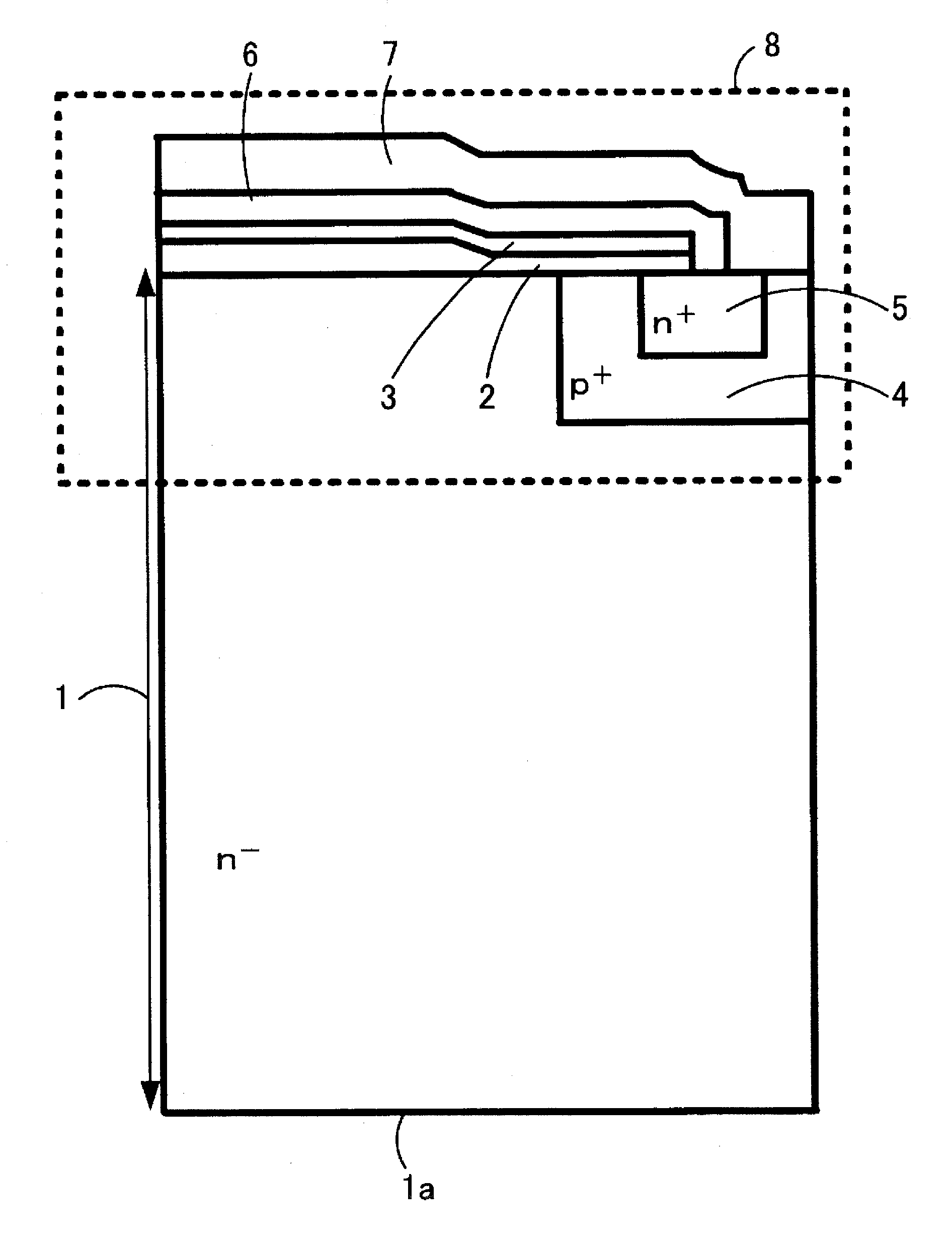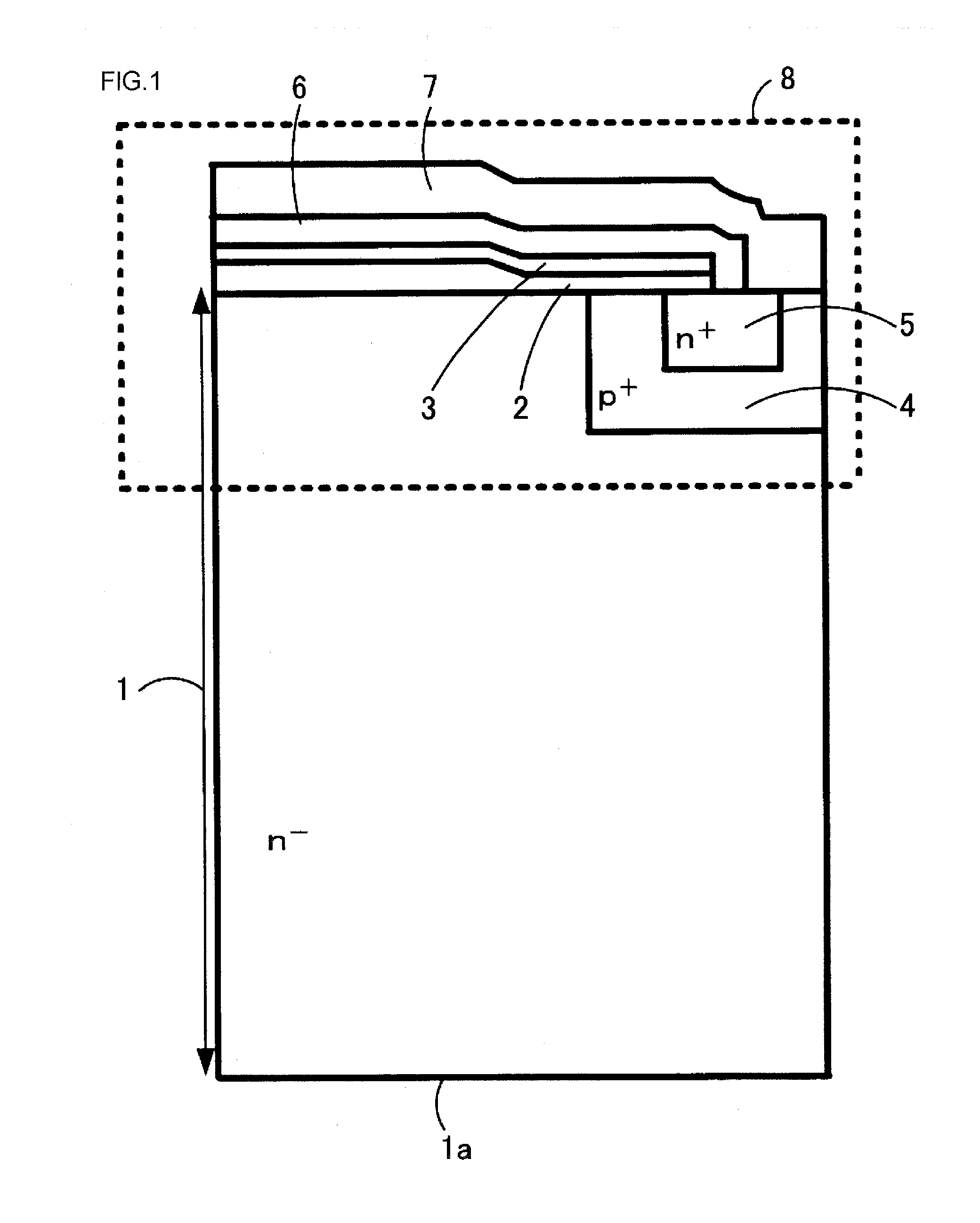Method for manufacturing semiconductor device
a manufacturing method and semiconductor technology, applied in the direction of semiconductor devices, electrical devices, transistors, etc., can solve the problems of insufficient repair of fs layer b>9/b> defects, inability to achieve low-temperature (350° c. to 500° c.) heat treatment, and the effect of increasing the effect of heat on activation
- Summary
- Abstract
- Description
- Claims
- Application Information
AI Technical Summary
Benefits of technology
Problems solved by technology
Method used
Image
Examples
embodiment 1
[0072]FIGS. 1 to 4 are cross-sectional views illustrating the method for manufacturing a semiconductor device according to Embodiment 1. In FIGS. 1 to 4, the cross-sectional views of the principal portion of the semiconductor device in the manufacturing process are shown in sequence. A FS-type IGBT 100 (see FIG. 4) is considered as an example of the semiconductor device. In the manufacturing process, the process performed on the front face side is identical to the conventional process (see FIGS. 12 to 14). Therefore, only the back face side process is explained herein. Portions identical to those of the conventional configuration are assigned with same reference numerals.
[0073]A front face structure 8 is formed on the front face of a FZ-N substrate 1b. Then, as shown in FIG. 14, the FZ-N substrate 1b is polished by back grinding or etching to the desired thickness from the back face side of the FZ-N substrate 1b and a thin wafer is obtained. As a result, a thin-film FZ-N substrate 1...
example
[0077]The preferred conditions of ion implantation and laser annealing will be explained below. FIG. 5 is a characteristic diagram illustrating the diffusion profile of the FS-type IGBT 100. The diffusion profile is a concentration profile measured by a Spreading Resistance (SR) method. In accordance with Embodiment 1, two types of FS-type IGBT 100 were fabricated that had different substrate temperatures during the fabrication process. The substrate temperatures were (a) room temperature (no heating; dot line in FIG. 5) and (b) 300° C. (the substrate was heated; solid line in FIG. 5). After the substrate temperature has reached the predetermined temperature, the substrate was held for 5 min and then laser annealing was performed by irradiating the back face of the substrate with laser light. A YAG 2ω laser was used as the laser, the irradiation energy density of the laser light was 4 J / cm2, and the pulse width was 100 ns.
[0078]The ion implantation conditions were as follows: ion im...
embodiment 2
[0101]FIG. 8 is a configuration diagram illustrating the principal portion of the apparatus for manufacturing a semiconductor device according to Embodiment 2. In the manufacturing apparatus shown in FIG. 8, laser annealing is performed to activate the ion-implanted dopants. This manufacturing apparatus is constituted by the laser irradiation unit 15, the optical system mirror 16 guiding the laser light 14 to the FZ-N substrate 1 (wafer), the substrate heating unit 31 that heats the FZ-N substrate 1, and a guide 32 (claw) fixing the FZ-N substrate 1 to the substrate heating unit 31. For example, the manufacturing apparatus shown in FIG. 8 can be used for manufacturing the semiconductor device according to Embodiment 1. By arranging the guide 32 that fixes the FZ-N substrate 1 to the substrate heating unit 31, it is possible to realize both a support unit for supporting the FZ-N substrate 1 and a heating unit for heating the FZ-N substrate 1.
[0102]With the manufacturing apparatus sho...
PUM
 Login to View More
Login to View More Abstract
Description
Claims
Application Information
 Login to View More
Login to View More - R&D
- Intellectual Property
- Life Sciences
- Materials
- Tech Scout
- Unparalleled Data Quality
- Higher Quality Content
- 60% Fewer Hallucinations
Browse by: Latest US Patents, China's latest patents, Technical Efficacy Thesaurus, Application Domain, Technology Topic, Popular Technical Reports.
© 2025 PatSnap. All rights reserved.Legal|Privacy policy|Modern Slavery Act Transparency Statement|Sitemap|About US| Contact US: help@patsnap.com



